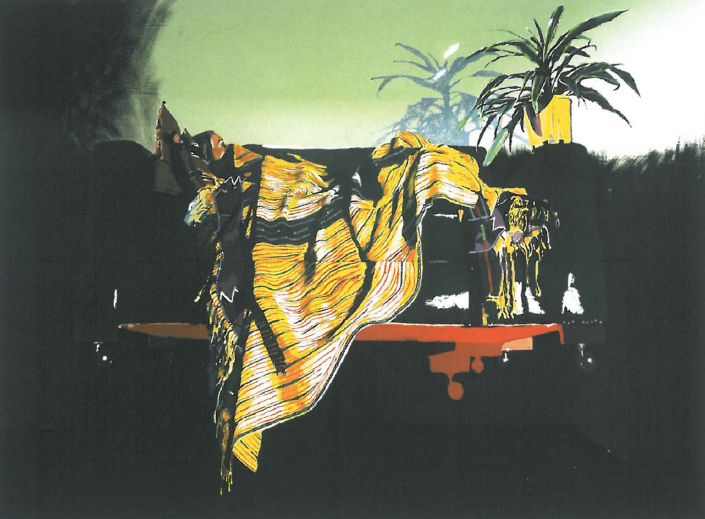
Simultaneous solo shows at CAST by three artists sit comfortably under the thematic umbrella of private, domestic space in a way that animates the objects of domesticity and allows for a relational dynamic to emerge.
As we enter the CAST Gallery it is not only the grand scale of sick by Amanda Davies that is confronting. The impenetrable surface of enamel paint applied to the back of thick, clear plastic acts as a bold statement that leaves the viewer somewhat bewildered. Bright, vivid stripes of colour bounce jarringly against a darkened ground, successfully muzzling the minute figure at the centre of the work in a claustrophobic grip. As in her other two works, Feeling at Home and Symptom 131, Davies makes a clever play with spatial disorientation so that although one is invited into her personal space one can never really feel quite at ease there. The minimalist use of positive/negative silhouettes and spaces in Feeling at Home take the viewer into some other-worldly dimension reminiscent of flashback images in The Dead Zone. Even more disconcerting, but in a cleverly humorous way, is Davies' depiction of three windswept figures in lifejackets superimposed over a domestic setting in Symptom 131. The contrast between the outdoor exuberance of the figures and the stable features of a domestic interior is an ambiguous dig at what we often unquestioningly call 'the familiar'.
An adjoining gallery space contains the work of craft and design artist Hermie Cornelisse. After experimenting with blindfolded art-making, Cornelisse moved towards a very complex and calculated approach in her later work. Where her blindfolded experience may have heightened the tactile senses associated with her materials, the paper cutting and folding of Buffer Zone: interactive layer between form and space is clearly an intricate composition that stimulates one's optical senses both in witnessing the meticulous steps of its construction and in the visual appreciation of its formal qualities. Minute squares and rectangles are cut into graph paper but not entirely removed. Here Cornelisse displays her acute sense of design as she folds sections of the cut paper in and out of the overall surface – a surface which, in its metal counterpart, could grate the zest from an orange. The sheet of paper is hung away from the wall so that an interplay of light and shadow extends the patterned surface into a third dimension. The paper-cutting and folding technique appears to flow over into Cornelisse's ceramic pieces, collectively titled Buffer Zone : deep space. My first impression was to think of cardboard boxes cut and folded in a variety of ways. There is something quite childlike and naïve in the simplicity of these ceramic forms: at one moment they can be either playful and imaginative, at another quite domestic and utilitarian.
Mish Meijers is the occupant of the third gallery space with her installation work The Tending of Inanimate Objects. According to the artist, this work deals with 'self-promotion that is postable'. The domestic objects are part of her sense of self: they are not only her favourite things but they act as a lens through which she can reveal herself to the world. The 'postable' nature of the work is evident in the three-dimensional presentation of digital images on Corflute constructed boxes – boxes that can be mass-produced, flattened and freighted to any address. Moving around these boxed forms is like invading the private space of the familiar, simply because the familiar has been taken out of its 'familiar' context. Additional components to The Tending of Inanimate Objects are the mixed media drawings on two adjacent walls. The freedom of scribbled lines, incomplete images and spontaneous text possess a somewhat nostalgic connection with the more rigid cardboard forms. It seems as if they contain the fragile inner spirit of the inanimate objects - a spirit that needs careful tending.












